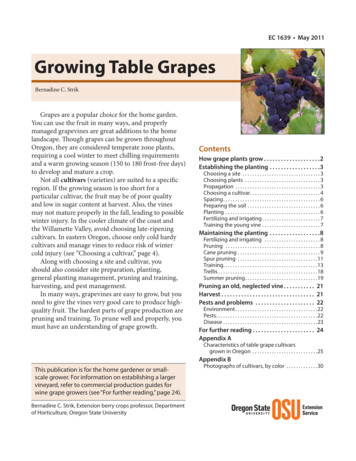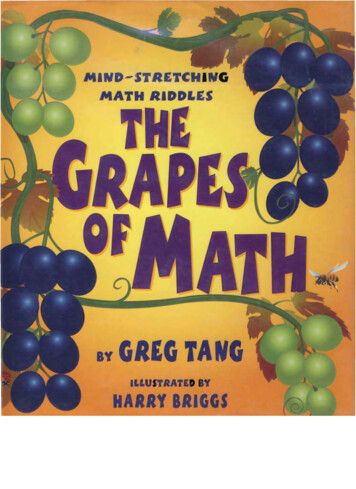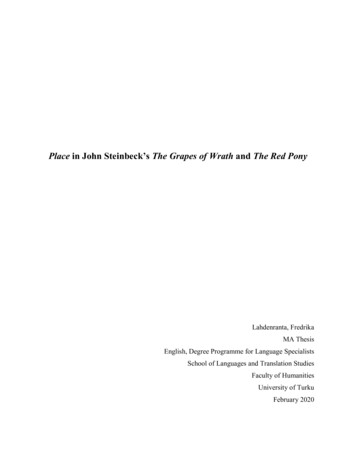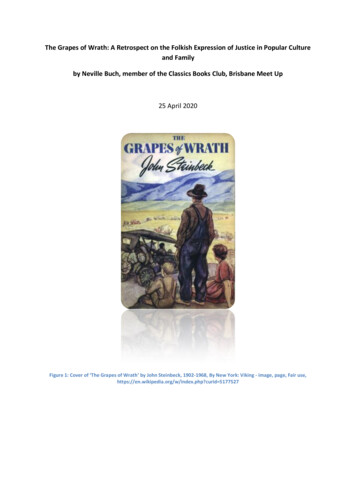
Transcription
EC 1639 May 2011Growing Table GrapesBernadine C. StrikGrapes are a popular choice for the home garden.You can use the fruit in many ways, and properlymanaged grapevines are great additions to the homelandscape. Though grapes can be grown throughoutOregon, they are considered temperate zone plants,requiring a cool winter to meet chilling requirementsand a warm growing season (150 to 180 frost-free days)to develop and mature a crop.Not all cultivars (varieties) are suited to a specificregion. If the growing season is too short for aparticular cultivar, the fruit may be of poor qualityand low in sugar content at harvest. Also, the vinesmay not mature properly in the fall, leading to possiblewinter injury. In the cooler climate of the coast andthe Willamette Valley, avoid choosing late-ripeningcultivars. In eastern Oregon, choose only cold hardycultivars and manage vines to reduce risk of wintercold injury (see “Choosing a cultivar,” page 4).Along with choosing a site and cultivar, youshould also consider site preparation, planting,general planting management, pruning and training,harvesting, and pest management.In many ways, grapevines are easy to grow, but youneed to give the vines very good care to produce highquality fruit. The hardest parts of grape production arepruning and training. To prune well and properly, youmust have an understanding of grape growth.ContentsHow grape plants grow. . . . . . . . . . . . . . . . . . . . 2Establishing the planting . . . . . . . . . . . . . . . . . . 3Choosing a site . . . . . . . . . . . . . . . . . . . . . . . . . . . . . . . .Choosing plants . . . . . . . . . . . . . . . . . . . . . . . . . . . . . . .Propagation . . . . . . . . . . . . . . . . . . . . . . . . . . . . . . . . . . .Choosing a cultivar. . . . . . . . . . . . . . . . . . . . . . . . . . . . .Spacing. . . . . . . . . . . . . . . . . . . . . . . . . . . . . . . . . . . . . . . .Preparing the soil. . . . . . . . . . . . . . . . . . . . . . . . . . . . . .Planting . . . . . . . . . . . . . . . . . . . . . . . . . . . . . . . . . . . . . . .Fertilizing and irrigating. . . . . . . . . . . . . . . . . . . . . . . .Training the young vine. . . . . . . . . . . . . . . . . . . . . . . .333466677Maintaining the planting . . . . . . . . . . . . . . . . . . 8Fertilizing and irrigating . . . . . . . . . . . . . . . . . . . . . . . 8Pruning . . . . . . . . . . . . . . . . . . . . . . . . . . . . . . . . . . . . . . . 8Cane pruning. . . . . . . . . . . . . . . . . . . . . . . . . . . . . . . . . . 9Spur pruning . . . . . . . . . . . . . . . . . . . . . . . . . . . . . . . . . 11Training. . . . . . . . . . . . . . . . . . . . . . . . . . . . . . . . . . . . . . .13Trellis. . . . . . . . . . . . . . . . . . . . . . . . . . . . . . . . . . . . . . . . . 18Summer pruning. . . . . . . . . . . . . . . . . . . . . . . . . . . . . . 19Pruning an old, neglected vine. . . . . . . . . . . . 21Harvest. . . . . . . . . . . . . . . . . . . . . . . . . . . . . . . . . . 21Pests and problems . . . . . . . . . . . . . . . . . . . . . . 22Environment. . . . . . . . . . . . . . . . . . . . . . . . . . . . . . . . . . 22Pests. . . . . . . . . . . . . . . . . . . . . . . . . . . . . . . . . . . . . . . . . . 22Disease. . . . . . . . . . . . . . . . . . . . . . . . . . . . . . . . . . . . . . . 23For further reading. . . . . . . . . . . . . . . . . . . . . . . 24Appendix ACharacteristics of table grape cultivarsgrown in Oregon . . . . . . . . . . . . . . . . . . . . . . . . . . . 25Appendix BThis publication is for the home gardener or smallscale grower. For information on establishing a largervineyard, refer to commercial production guides forwine grape growers (see “For further reading,” page 24).Bernadine C. Strik, Extension berry crops professor, Departmentof Horticulture, Oregon State UniversityPhotographs of cultivars, by color . . . . . . . . . . . . . 30
How grape plants growHere is an explanation of terms usedArmto describe parts of the grape plant or itsgrowth.Cane. A mature shoot after harvest andFruiting caneRenewal spurleaf fall; a shoot becomes a cane afterthe growing season.Cordon. An extension of the trunk,usually trained along a wire, fromwhich spurs grow.TrunkFruiting zone. The section of a shootwhere fruit clusters appear.Head. The top of the trunk where ittransitions to cordon, spurs, or canes.Internode. Portion of the shoot or cane Figure 1A. Dormant grapevine after pruning.between two nodes.Lateral. A branch of a shoot or cane.Node. (1) Thickened portion of the shoot where the leaf andlateral bud appear; (2) the place on a cane or spur where abud appears.Shoot. New green growth with leaves, tendrils, and often flowerclusters, developing from a bud on a cane or spur.Spur. A cane pruned back to one to five buds. A spur is on acordon or at the head of the vine.Sucker. Also called a “water sprout”; a shoot growing from oldwood, often at the trunk base or at the head of the vine.Veraison. The start of grape ripening, when color changebegins. Green berries start changing to red or blue in acolored grape cultivar, or a green grape becomes moretranslucent. In the Willamette Valley, this change occurs inFigure 1B. Shoot.about mid-August.Fruiting caneA dormant grapevine is illustrated in figure 1a. In the spring,shoots grow from buds on canes, renewal spurs (if present), andsometimes the trunk. Each bud on a cane or spur may producefrom one to three shoots. As the shoot grows, it can produceleaves, flower clusters, buds, and lateral branches (figure 1b andfigure 2). Fruit is produced on the current season’s growth.When the vine is dormant once again (generally fromDecember through March), you must prune it. The buds thatproduce next year’s fruit are on the 1-year-old canes (last year’sgrowth). To prevent the vine from producing too much fruit(overbearing), you must prune to keep only some of the 1-yearold wood or canes and remove the rest. Overbearing delays fruitripening, reduces fruit quality, and weakens the vine.Figure 2. Early grape shoot growth.Growing Table Grapes2
Establishing the plantingGrapevines require several years from time ofplanting to first harvested crop, and they normallydo not reach full production until the fifth orsixth year. Grape plants live for 50 to 100 years,if you care for them properly. It’s relatively easyto propagate a favorite vine (see “Propagation,”this page) but well-established plants cannot betransplanted. Thus, it’s important to considercarefully both where you will plant and how youwill prepare the site before you plant.Choosing a siteThe first step toward consistent production ofhigh-quality grapes is to choose a sunny place toplant. While some ornamental grapevine speciesperform adequately in partial shade, full sunlightis required to get good production of table grapes.If you plant a row that runs north–south, the fruitand leaves will be better exposed to sunlight thanin east–west rows; this way, you’ll produce betterquality fruit.Grapes can be grown on a wide range ofsoil types and soil nutrient status (for example,soil acidity or pH). European grapes may growbetter than American types on soils with a pHgreater than 7 (see “Choosing a cultivar,” page 4).Grapevines may have nutritional problems whengrown on soils with a pH greater than 8.Grape plants grow best in well-drained soils.Heavy clay soils with poor drainage or soils withan impervious subsoil clay pan are not ideal.Building up raised beds may improve growth onthese soils.When selecting a site, avoid areas prone to earlyspring frosts. New shoot growth in April and Mayis very susceptible to frost injury (see “Pests andproblems,” page 22). Home surroundings or othersites that are sheltered from colder temperaturesand wind are best. If possible, choose a slopingarea, especially a south or southwest slope, becauseit generally has higher temperatures and is lesslikely to get frost.Vines that are stressed due to drought or shadeare more prone to diseases such as powderyGrowing Table Grapesmildew or botrytis fruit rot (see “Pests andproblems,” page 23).Choosing plantsPurchase dormant bare-root vines or young, wellrooted, potted plants (generally grown in 1-galloncontainers). There is no need to buy older plants. Inretail nurseries, nongrafted vines (also called “selfrooted”) are most commonly available. Nurseriesmay sell grafted plants of some cultivars. Europeanwine grapes are often grafted onto a rootstockresistant to the root-feeding insect phylloxera (see“Pests and problems,” page 22). Many table grapes aretolerant or resistant to phylloxera.When choosing a bare-root or container plant,pick one that will be easy to prune back to a fewbuds or to a vigorous basal shoot, to encouragedevelopment of a straight trunk (see “Training theyoung vine,” page 7).PropagationOften, home gardeners want to propagatean older vine that is in the wrong spot or hasbecome too old to rejuvenate (see “Pruning an old,neglected vine,” page 21) or a wonderful varietya friend successfully grows. You must propagategrapes from cuttings rather than seeds, becauseseedlings don’t have the same characteristics as theparent plant. Propagating by dormant, hardwoodcuttings is simple.It’s easiest to take hardwood cuttings late in thedormant period. This ensures that the grapevinehas had enough winter cold (chilling) to give budsa chance to grow normally in spring. Ideally, takecuttings right before pruning in February. Select1-year-old dormant canes (those that were newshoots the previous summer). Choose healthycanes that look like they grew in full sunlight.Canes growing in partial shade may be spindly andmay not have enough stored food to support thecutting until it has developed leaves and roots.Select canes that are at least pencil-size indiameter. Avoid choosing canes that are too big orhave very long internodes (longer than 6 inchesbetween buds on a cane). Make each cutting longenough to include three buds. Take cuttings by3
making a straight cut just below the basal bud (budclosest to trunk) and a slant cut in the internodeabove the top bud of each cutting (figures 3A and3B). This system allows you to easily identify thebottom and top ends of each cutting (cuttingswon’t root if they’re placed upside down).No matter how much careful attention youpay to grape cuttings the first year, some maynot develop a strong root system. Therefore,it’s generally preferable to root and grow grapecuttings for 1 year in a garden area or propagationbed before transplanting them to a permanentlocation.Cuttings taken in February can be set directlyin a propagation bed. If you take cuttings earlier inthe dormant season, store them in vented plasticbags in the fridge (without any fruit) for about amonth, to satisfy the chilling requirement.Set cuttings 6 inches apart in rows 2 to 4 feetapart in well-drained, tilled soil. You may tilla well-balanced fertilizer such as 16-16-16 at arate of 1 cup per 10 feet of row into the top 3 to6 inches of soil. You can also use 1-gallon pots3Acontaining good potting soil. Place only onecutting per pot. Pots must have drain holes.Stick cuttings into the loose soil so that thebasal and center buds are covered and the top budis just above the soil surface (figure 3C). Make surethe cutting is right side up, with the slanted cut atthe top. You don’t need to use rooting hormones.Press soil firmly around the cuttings.If you live in a cold area such as central oreastern Oregon, you must protect cuttings in thepropagation bed from heavy frost. Cover the top ofthe cutting with soil and mulch. Carefully removethis material to expose the top bud once thedanger of frost is past. Buds will break and shootswill grow slightly before root development.Irrigate, when necessary, to maintain adequateand consistent soil moisture levels in the firstyear. Keep the propagation area free of weeds.Rooted cuttings can stay in the nursery row untilyou transplant them to their permanent location,before growth begins next spring. If you arepropagating in containers—in a greenhouse, forexample—make sure the newly rooted plant doesnot become root-bound, and thatyou transition plants carefully to theoutside so that they become wellacclimated. Transplant well-rootedplants in early spring the followingyear when they are dormant.Choosing a cultivarThere are many grape cultivarsavailable. You’ll find descriptions ofcultivars in Appendix A (page 25).Local climate or growingFigure 3A (top). Old cane, showing the cuts required to make two cuttings.conditions greatly influence aFigure 3B (bottom). Cutting, three buds long, showing basal and top ends.cultivar’s performance. Be sure tochoose a cultivar that is adaptedto your region. Regions differ in minimumwinter cold temperature, but also in summer2–3"temperature or growing degree days (GDD)Ground level(table 1, page 5). Some cultivars, such as Niagaraand Concord, require at least 2,000 GDD toripen fully. Canadice, Interlaken, Reliance, andmany other early to mid-season cultivars require1,500 to 2,000 GDD to ripen fruit. If you liveBasal endin cooler regions, such as the Oregon coast and3B4–6"Figure 3C. Proper way to set a cutting in a propagating bed.Growing Table Grapes4
parts of the Willamette Valley, choose only earlyto mid-season cultivars. Late-season cultivarsmay not fully ripen their fruit every year in theseregions, though this can be influenced by pruning(see “Pruning,” page 8).Table 1. Average growing degree days (GDD)(base 50 F, from Jan. 1–Dec. 31) in citiesthroughout Oregon.CityAverage of approximately 70 ,0311,478Source: Oregon Climate Summaries ng-degree-day units are computed as the difference between the daily average temperature and thebase temperature. (Daily Avg. Temp. - Base Temp.)One unit is accumulated for each degree Fahrenheit theaverage temperature is above the base temperature.Negative numbers are discarded.Example: If the day’s high temperature was 95 F and thelow was 51 F, the base 50 heating degree-day units are95 51- 50 232This is done for each day of the month and summed.It’s important to consider a cultivar’s diseaseand cold tolerance (see “Pests and problems,”page 22). Tolerance to winter cold temperaturesinvolves the health of the vine, yield the previousseason, how well the vine became dormant, howquickly the temperature gets cold and how long itstays cold, and other factors. Dormant buds maybe damaged at one temperature and trunks atanother temperature. See Appendix A (page 25)for comments on cold hardiness of cultivars.Because grapes are self-fertile, you need onlyone cultivar for fruit production. But, for varietyGrowing Table Grapesand to extend the fruiting season, you may chooseto grow several very early, mid-, or late-seasonripening cultivars (depending on your climate).Each cultivar’s fruit is unique in its aroma,flavor, and other qualities. When choosing acultivar, try to determine which ones have a flavoryou like. You can often find unique cultivars totaste at U-pick farms, farmers markets, or throughyour county’s OSU Master Gardener Program.Depending on the cultivar, fruit may be suitedfor fresh eating, juice, raisins, jellies, or wine. Somecultivars suit more than one purpose. Generally,sweet seedless grapes with tender skins are best forraisins.Three types of grapes are grown in the PacificNorthwest: American, European, and EuropeanAmerican hybrids. Each has specific qualities. American cultivars (Vitis labrusca) have astrong “foxy” flavor and aroma (characteristicof Concord, the most common cultivar usedfor purple grape juice). Fruit generally have aslip-skin (pulp separates from the skin whenyou pop the berry in your mouth). Americancultivars that have a slip-skin are noted inAppendix A (page 25). The cluster can varyfrom tight to loose and berries from small tolarge, depending on cultivar.Plants tend to be more tolerant of pests andmore vigorous than the European type.This type of grape is tolerant or resistant tophylloxera, and it is more disease-resistant andcold hardy than the other types. These cultivarsare used mostly for juice, jellies, pies, and fresheating. European cultivars (Vitis vinifera) differ fromAmerican cultivars in fruit characteristics,vine growth habit, and climate adaptation.They have tight clusters, berries with thin skinsthat do not “slip,” and a more subtle aromaand flavor. Some cultivars have berries with a“crunchy” texture. In general, European grapecultivars are more sensitive to pests (such asphylloxera) and diseases (such as powderymildew and botrytis bunch rot) and are lesscold hardy than American types. For thesereasons, European-type table grapes are not ascommonly grown in home gardens in Oregon.5
European-American hybrids have somecharacteristics of both American and Europeantypes, depending on parentage.Cultivars in Appendix A (page 25) aredesignated as European (E) or American (A).Hybrids are indicated as “A” with flavor and otherattributes noted. See Appendix B (page 30) forphotos of some cultivars.Cultivars differ in ripening time, characterizedby season as “very early“ to “late.” Note thatcultural practices (such as pruning) and weathercan influence harvest time. In the WillametteValley, very early season cultivars would be readyfor fruit harvest in early September. Late-seasoncultivars, such as Concord, may not be ripe untilmid-October when pruned well.Yield per vine varies tremendously with vineage, site (climate, depth of soil, soil fertility),management (pruning, irrigation, plant fertility,pest management), and cultivar. Yield per plant,for a mature, well-managed vine, may be from15 to 35 pounds.SpacingSpacing within the row depends on the cultivaryou plant, the depth or fertility of your soil, andthe training system you use (see “Training,”page 13). Plant European cultivars (Vitis vinifera)6 feet apart in the row. You can set Americancultivars (V. labrusca) and hybrids 6 to 8 feetapart in the row, because they are more vigorous(produce longer shoots). If your soil is shallow orof low fertility, you can space vines closer togetherin the row to “fill” the trellis.The spacing between rows depends, in part,on the training and trellis system you choose. Inbackyard plantings, 9 to 10 feet between rows iscommon for single canopy training systems (headtrained, single downward hanging canopy, verticalhedgerow or VSP, and Scott Henry). If you plan totrain to a Geneva Double Curtain (GDC) and willhave more than one row of vines, use a betweenrow spacing of 11 to 12 feet.Preparing the soilBe sure soil is free of perennial weeds andwell tilled before you plant. You can improveGrowing Table Grapesthe organic matter content of heavy soil byincorporating well-aged sawdust, manure, orcompost.Don’t place manure or compost directly in theplanting hole. Instead, incorporate it into soil inthe whole planting area. Apply organic matter thesummer or fall before you plant. Manure appliedat 2 to 3 cubic yards per 100 square feet is a goodsource. Use only materials that you believe are freefrom insects and weed seeds. Dig, plow, or till thematerial into the soil to ensure that it will be welldecomposed by planting time.If you incorporate large amounts of non decomposed material into the soil, add calciumnitrate (16 percent nitrogen) or equivalentfertilizer at 2 pounds of product per 100 squarefeet to aid in decomposition. If you also usemanure to improve soil structure, decrease the rateof fertilizer by half.PlantingPlant grapes in early spring, as soon as youcan work the soil. If you buy dormant, bareroot plants, make sure roots don’t dry outbefore planting. If you’re transplanting from apropagation bed or nursery, dig plants carefully toavoid breaking roots.At planting, prune off all broken roots and trimvery long roots. Set plants in a hole large enoughto spread roots without bending them. For plantsgrowing in a pot, remove the pot (whether it’s fiberor plastic) and place the rootball into a sufficientlylarge hole. Plant all bare-root or potted plantsat the same depth that they were growing in thenursery.Firm the soil well around roots to removeair pockets, and water thoroughly. Continue toirrigate plants as required to keep soil adequatelymoist without saturating it.Right after planting, prune off all but onevigorous 1-year-old cane from nursery-boughtplants. Prune the cane back to two buds. On plantsthat are already growing, remove all but the mostvigorously growing shoot near the base of theplant. This will become the new trunk.Young grapevines can’t compete with weedsor established lawn grass for water and nutrients.Keep the planting free of all weeds in the6
establishment years. Cultivate shallowly, nodeeper than 1 to 3 inches, to avoid injuringroots.Grapevines can be planted throughblack plastic. The plastic mulchreduces weed growth and increases soiltemperature (which may benefit rootgrowth in western Oregon). Place theplastic down the row before planting. Cutholes in the plastic about 1 foot in diameterwhere you will plant the vines. The blackplastic lasts 1 to 2 years. Be sure to disposeof it appropriately before it deteriorates toomuch.Fertilizing and irrigatingIn general, fertilize grapes sparingly.More problems occur from overfeedingthan from underfeeding. In the plantingyear, fertilize each plant with a total of0.5 to 1 ounce of nitrogen (N), dependingon soil fertility. Use a well-balancedfertilizer such as 16-16-16. To calculatehow much product to apply, divide thedesired amount of N (in this case, 1 ounce)by the percentage of N in the fertilizer:16% 0.161 oz 0.16 6.3 oz product per plantYou also may use manure or compost.In the second year, plants may befertilized with 1 to 1.5 ounces of N perplant if needed. Broadcast the fertilizerin a circle about 6 to 18 inches from thetrunk. Be careful not to get fertilizer rightup against the trunk or to place it all in onespot near the vine. The best time to fertilizeis around bud break.Newly planted vines need properwatering to establish in any soil type.Keep the soil sufficiently moist withoutoverwatering.Training the young vineThe main goal of training the vine inthe establishment year is to develop awell-established root system and a trunk.Growing Table GrapesTie to base wireWeave shootaround twineCut through budFigure 4. Training in the planting year (short parallel lines showpruning cuts).In the planting year, select the strongest shoot that growsfrom each newly planted vine and train it to a stake ortwine that’s attached to the trellis wire, so that it develops astraight trunk. Prune off all other shoots before they growlonger than 12 inches so the vine can direct its growth tothe new trunk (figure 4).Sometimes the shoot won’t reach the training wire ordesired head height in the first year. If this happens, pruneit back the next winter to three or four buds. It may seemyou’ve wasted a whole year’s growth, but the root systemis considerably larger. Provided there is no adverse soil orpest condition, you should get much better trunk growthin the second year. In this case, train the strongest shootthat grows the following summer and prune off all others.In colder regions, it is common just to grow a bush thefirst year and train the trunk in the second year. Also, youcan train more than one trunk in cold regions to reducethe risk of losing the plant to cold injury (see “Pests andproblems,” page 22).Once the shoot reaches the wire or desired head height,do not top it during the growing season. Instead, wait untilthe vine is dormant. Cut it at a node (through a bud) about3 to 4 inches above the desired height, and tie it to the wire(figure 5A, page 8).Further training and pruning depend on the trainingsystem you choose (see “Training,” page 13). Once youchoose the training system, you’ll build a trellis (see“Trellis,” page 18).No fruit is produced in the planting year.7
Maintaining theplantingFertilizing and irrigatingYoung, establishing vines or plantsgrown on soil of low fertility may benefitfrom annual applications of fertilizer,manure, or compost (to supply about1 ounce of N per plant).Irrigate vines, if necessary, to help theplants survive dry periods and mature theirfruit. If vines grow so vigorously that theydevelop dense canopies, increased disease,and reduced fruit production, be sure togradually decrease amounts of water inmid- to late summer.Older vines grown on sandy soils (suchas those found in central and easternOregon) require irrigation to ensure goodplant growth and fruit production. Grapesgrown on clay-loam soils in the WillametteValley can be grown without irrigation.But in the Willamette Valley’s long, drysummers, it’s often helpful to give plants asmall amount of irrigation during the latterstages of fruit ripening. This helps preventberry splitting, which can happen late inthe season after rainfall on unirrigatedvines.In coastal areas and the WillametteValley, be sure not to over-irrigate aproducing vine. Always irrigate fruitingvines under the canopy to lessen thedevelopment of disease.high-quality fruit and maintaining a balance betweenvegetative growth and fruiting. The most commonproblem in home garden grape production is that vinesaren’t pruned hard enough. When you prune, you mustremove most of the wood produced the previous season—prune off about 90 percent! Leave relatively little wood toproduce the following season’s crop. If you prune properly,your vine will be more manageable and have better fruit.Poor pruning year after year leads to a low yield and poorfruit quality.Prune vines when they’re dormant, from Januarythrough early March. If the vine bleeds sap from the cutportions, don’t worry: there is no evidence that this harmsthe vine.There are two methods of pruning: cane pruning andspur pruning. Once you understand these methods, you’llbe able to prune a vine no matter what training system youuse.Some cultivars perform best when they are canepruned, and others when they are spur pruned. The bestpruning method to use (when known) is shown in thecultivar descriptions in Appendix A (page 25). In general,European grapes may be cane or spur pruned. Othercultivars, especially American types and many hybrids,produce only vegetative shoots on the basal buds of canes.If these are pruned to short spurs, they produce little or nofruit. For this reason, it’s best to cane prune cultivars whenno specific pruning method is recommended.In cooler areas of the Willamette Valley or the coast,spur pruning can promote crowded shoots, thus increasingthe risk of fruit rot. It may be an advantage to cane prunein these cooler regions.WirePruningThe framework of an establishedvine—the way it looks after pruning—varies depending on the training systemyou choose. The pruning instructions thatfollow are for a vine trained to a singledownward hanging canopy. Other trainingsystems are described in the section on“Training” (page 13).Proper pruning and training areessential for producing a good yield ofGrowing Table GrapesFigure 5A. Cane pruning, first winter.8
Cane pruningThese instructions are for a singledownward hanging canopy.Second growing seasonYou’ve planted on a site with goodfertility. At the end of the first growingseason, you trained the vine to a stakeor wire to attain the desired head height.You pruned the trunk the first winter(figure 5A, page 8).In the second growing season, shootsdevelop from buds on the 1-year-oldtrunk. Retain two shoots that grow 2 to6 inches below the training wire. Trainthese shoots, one on each side of the trunk,along the wire. These shoots become thefruiting canes for next year.Remove all shoots, other than the twoyou selected, while they’re still small. Youwant the vine to direct its energy to thetwo shoots you want to keep. The vine istoo young to produce any fruit, so pruneoff any clusters before or at bloom. Also,remove any suckers that develop at thebase of the vine (figure 5B).In the second winter, prune back the twocanes to 7 to 10 buds each, depending onvigor (14 to 20 buds per plant, figure 5C).These buds would produce fruit, andit’s important not to let young vinesoverproduce.Figure 5B. Cane pruning, second growing season (double linesshow pruning cuts).Figure 5C. Cane pruning, second winter (double lines show pruningcuts).Third growing seasonShoots grow from buds on the 1-yearold canes you left at pruning, and theseshoots produce fruit (figure 5D). Youmay need to remove any extra shootsthat develop from buds at the nodes (see“Shoot thinning,” page 19). If there is anaverage of more than one fruit clusterper shoot, prune off the extra clusters atbloom to prevent the young plant fromoverbearing (see “Fruit thinning,” page 20).The grapevine in the third winter,before and after pruning, is illustrated infigures 5E and 5F (page 10). You mustGrowing Table GrapesFigure 5D. Cane pruning, third growing season.select new fruiting wood and remove the rest (about90 percent) of the canes. When you choose fruiting canes,be aware that canes differ in fruitfulness.The most fruitful canes are tho
wine grapes are often grafted onto a rootstock resistant to the root-feeding insect phylloxera (see "Pests and problems," page 22). Many table grapes are tolerant or resistant to phylloxera. When choosing a bare-root or container plant, pick one that will be easy to prune back to a few buds or to a vigorous basal shoot, to encourage










